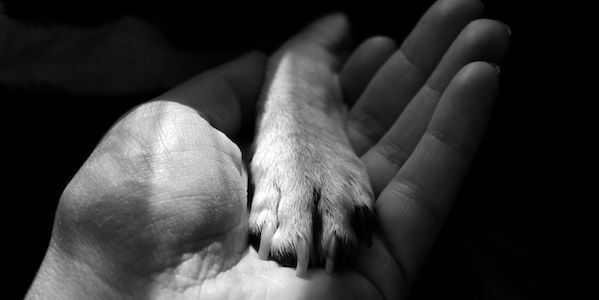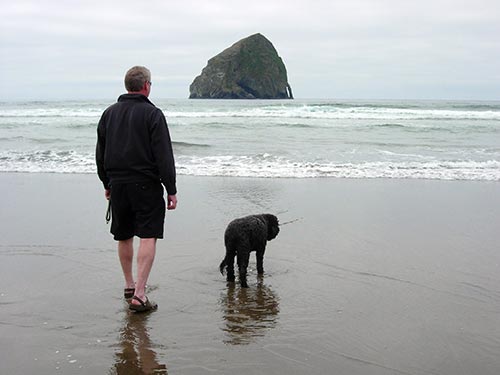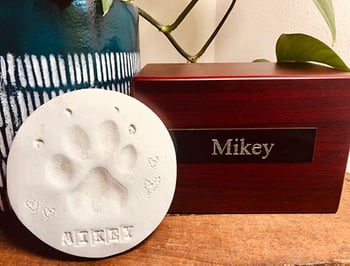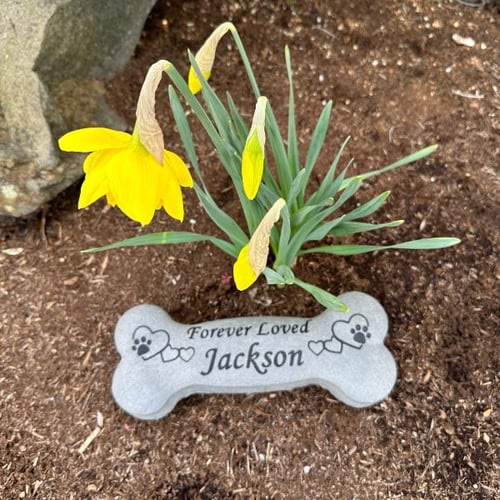 One of the most beautiful parts of having a pet is the human-animal bond that develops. For many people, a pet becomes part of their family, much like a human child.
One of the most beautiful parts of having a pet is the human-animal bond that develops. For many people, a pet becomes part of their family, much like a human child.
For anyone who has pushed their dog or cat down the sidewalk in a stroller, let their pet sleep in their bed (or even under the covers), stayed up late with their pet after surgery or when that pet is feeling sick, then your relationship is on the level of family.
It is understood, although not often acknowledged, that the heartbreaking part of having a pet is that their lives are so much shorter than ours. When a pet is brought into the home, they weave themselves into the fabric of your life and often will pass away before their human family counterparts.
End-of-life care is a shared experience for all pet owners. Although all pets will transition away from this world in different ways, many pet owners will have to witness a decline in quality of life. They will have to make a difficult decision about choosing euthanasia for their pet.
To anyone going through a decision on euthanasia or witnessing their pet struggle with waning quality of life, I send my love and comfort your way. You do not have to go through this process alone.
During this difficult time, you'll need to consider these end-of-life options for your pet:
- Let your pet pass away naturally when it is time. Stay in close communication with your veterinarian for guidance to avoid prolonging serious pain or suffering of your pet.
- Try to extend your pet’s life length as much as possible – this strategy often results in emergency veterinary visits (inevitably in the middle of the night) to euthanize.
- Maximize your pet’s quality of life and then strategically choose the time of euthanasia while your pet still has dignity (for example, some dogs know that they shouldn’t potty inside but are too weak to hold it).
There are many reasons why I believe you should consider at-home or in-home pet euthanasia.
This article will examine the concepts of quality of life and euthanasia, why euthanasia is performed on pets, the process of having a pet euthanized at home, and what to expect.
What Is Quality of Life for Pets?
 The quality of a pet’s life is different for each individual pet and has to do with their disease process, their pain level, their mobility, ability to engage in normal activities, mental state, and other factors specific to their home, family, and finances.
The quality of a pet’s life is different for each individual pet and has to do with their disease process, their pain level, their mobility, ability to engage in normal activities, mental state, and other factors specific to their home, family, and finances.
There are numerous factors and combinations of factors that come into play that are different for each patient and each family.
Fortunately, a series of tools have been created to help you sort through these factors and assess quality of life.
Below are some links to quality-of-life assessment tools you can use for your senior or ill pet for guidance. The tools will help you evaluate how your pet performs in basic, daily situations and how that translates to their quality of life.
These tools can be used independently or together to help you understand if your pet has quality of life and, if so, how much quality.
- Quality of Life Scoring Tools
- Quality of Life Calendar (print out and track your pet’s progress)
How Do You Know 'When It's Time'?
Dr. Dani McVety shares her insights in this video on how to know "when it’s time” to say goodbye to your pet:

Another quality-of-life tool is the Pet Hospice Journal. You do have to make an account, but the use of the tool is free. Once you log in, the program will help you score your pet’s quality of life based on daily life events.
The information is stored and becomes a “journal” in that you can compare your pet’s scores day-to-day. This kind of program is great for identifying trends and seeing progression over time.
What is Euthanasia?
The word euthanasia literally means “good death.” The meaning of the word is exactly why we perform the procedure – to prevent further pain and suffering at the end of life.
There are a variety of reasons veterinarians perform euthanasias – poor quality of life, terminal medical conditions, unrelenting pain, inability to re-home a pet because of severe behavioral/safety concerns, caregiver burnout, and the list goes on.
Each pet and each situation is different, and a veterinarian will often be able to help you decide if, based on your pet’s condition, they are a candidate for euthanasia.
Euthanasia is a tool we can use to end suffering when nothing else can be done to help the pet. Although many of my clients often feel guilty about choosing euthanasia for their pet, it is considered an act of compassion, mercy, and love.
Euthanasia isn’t an option available in human hospice care in many areas, despite the immense pain and suffering some humans face at the end of their life.
Consider the alternative. Without euthanasia, some pets may suffer unrelenting pain; others will entirely lose track of who they are and where they are. Some pets would be unable to walk, and others would drown in their own internal body fluid during heart failure.
As a pet parent, I would rather have a little less time with my pet and have that time be good quality time together. The alternative is to have a little extra time, but my pet would be suffering needlessly.
Another consideration is that without euthanasia, there’s a risk of having your pet pass away alone when you aren’t home.
Who Performs Euthanasia at Your Home?
There are several options available when you are considering in-home euthanasia. First is your family veterinarian. Sure, they have a brick-and-mortar practice, but some veterinary hospitals will send a veterinarian to your home if requested.
Another option is veterinary companies that send veterinarians specifically to provide in-home hospice and euthanasia for pets. One company has a nationwide presence, while the others have more of a state-wide or local presence.
Below are a few companies with larger service areas, but you can also type “in-home euthanasia (your city, state)” into Google and see what services are available to you locally.
- Lap of Love
- Pet Hospice (West Coast)
- CodaPet (Fresno, CA and Oklahoma City)
Why Perform Euthanasia at Home?
Is it better to have your dog or cat euthanized at home? I personally think so, but ask someone you know and trust who has been through the process.
If you know someone who has been through euthanasia in a veterinary hospital and another euthanasia at home, that perspective is even better.
If you need more information, read through the pet hospice websites listed above or call their teams and ask questions. There are also lots of online reviews that you can read through.
Every person I have talked to who has experienced an in-home euthanasia has said they will always have it performed at home in the future.
Full disclosure: I decided to join Lap of Love and provide in-home euthanasia and hospice care. I believe it’s an important service, and I want to help maintain the human-animal bond and create a peaceful and personal experience for families at this very difficult time in their lives.
Is an In-home Euthanasia Right for Your Family?
Here are some questions to ask yourself:
- Does your dog ever get scared, nervous, or aggressive when they go to the veterinary hospital? Does your cat become stressed when put in a carrier and taken to the veterinary clinic?
- If so, then euthanasia at a veterinary hospital may make those feelings the last feelings they have at the end of their life.
- If so, then euthanasia at a veterinary hospital may make those feelings the last feelings they have at the end of their life.
- If you could take the place of your pet, where would you want your last moments to be?
- If your pet is indifferent to or even likes going to the vet, then you have many more options available to you.
- If your pet is indifferent to or even likes going to the vet, then you have many more options available to you.
- If you have been present at a pet’s euthanasia in the past, what was that like for you? Do you think the experience could have been better?
- If you have a larger dog that can no longer get into the car to get to a veterinarian, a veterinarian can come to you.
- Do you have a barrier that keeps you from getting to a veterinary hospital with your pet – like not having a car, having a disability, having a busy schedule to work around, or not having childcare?
- If you have other pets, returning to the veterinary clinic for their future appointments may be difficult due to the reminder of what happened there.

How to Make Your Pet’s Last Days Special
If your pet is getting older, it may be a good idea to create a “bucket list” for your pet. What have you always wanted your pet to experience?
If there are certain places you want your pet to visit before the end of their life, then start making plans! I will caution that feeding certain fatty human foods may make your pet feel very sick, vomit, or have diarrhea – so don’t go crazy in the food department.
For Cats:
- Cats may enjoy ½ a sardine with their meal
- Some cats who have been kept inside but are interested in the outdoors may enjoy a short, supervised outdoor exploration session (using a covered playpen, like this one, is an easy way to allow them some outdoor smells and enrichment without the fear of them running off)
- Cats don’t often need extensive stimulation for happiness. For example, make sure they can reach their favorite sunny napping spot.
For Dogs:
- Bring them to their favorite outdoor spot for a day in the sun
- For dogs who like car rides, plan a series of stimulating car trips
- Get your dog a "pupsicle," some chicken or other (low-fat) tasty treat, and spoil them a little
- If your dog likes dog parks, take a tour of all the dog parks in your area
- If your dog likes swimming, find a lake, stream, or ocean they can play in
- The ideas are endless – what does your dog love? Then, make a plan based on the answer.
Preventive Vet dog, Beau, who passed away in 2013, hadn’t yet been to the ocean. So, one of his bucket list experiences was to go see, hear, smell, and feel the ocean.
Being a Portuguese Water Dog who had only experienced lakes and rivers, he was in awe. It was a memorable family trip, and he loved his experience.


What to Expect When a Pet Is Euthanized at Home
A veterinarian will come to your home at a time you decide upon. The veterinarian will talk you through the euthanasia process and their protocol. They will also tell you about how the body acts during the process.
The veterinarian will get permission from you before they start the euthanasia to make sure you are ready (none of us ever are). The process is quick and painless, and your pet will transition to be at peace in the comfort of their home and in the presence of their family.
After Euthanasia
Generally, there are three options once your pet has passed away. You can bury your pet at home if your state and locality allow, or you can have your pet cremated (traditionally or through aquamation cremation).
If you select a private cremation service, your pet’s ashes will be returned to you, usually in an urn. Some people may wish to keep their pet’s ashes. Others may want to scatter their pet’s ashes at their favorite outdoor spot, in a garden, or at the beach of an ocean or lake.
Scattering your pet’s ashes is a way some people choose to part with their loved one’s physical body while reconnecting with their love and spirit.
 Find a Special Way to Honor Your Pet’s Life
Find a Special Way to Honor Your Pet’s Life
Our pets are incredibly important to us. After they pass away, creating a memorial of some kind can help you process your pet’s transition. Here are some ideas:
- Put together a shadow box including your pet’s collar, toys, or other items
- Create a photo album
- Have a 3D photo crystal made of your pet
- Have a candle-lighting ceremony
- Plant a tree with your pet’s ashes and watch it grow
- Use your dog or cat’s collar and their water bowl for a potted plant
- Plan ahead and order the kit to imprint their paw on silver jewelry
- Keep a Pet Remembrance Journal
- Paint a picture or a stone and place it somewhere in your home or yard. You can buy memorial stones like the one our team has ordered in the past, featured below.
Grief Resources for Pet Loss
The loss of any family member is a devastating experience. Everyone grieves a little bit differently. For some, the grief can be overwhelming.
To anyone reading who is overwhelmed with grief after the passing of their pet, you are not alone. There are some helpful resources available to you: books, discussion groups, helplines, and more.
- Best Friends Animal Society has an article full of great resources
- Rainbow Bridge Pet Loss Grief Center is a website with tips about grieving, coping, understanding when you are ready for a new pet, and more.
- Pet Hospice has resources and telehealth consultation services
- The Association for Animal Bereavement
- The Pet Loss Resource Center
- Pet Loss Community has grief support groups for those whose pets have passed, as well as anticipatory support for those who are struggling with the thought of losing their beloved pet.
- Facebook Group Pet Hospice Community
- Forever Friend: A children's guide and activity book for saying goodbye to a special dog
We were moved by this article. It's a worthwhile read.
"The best thing to do is integrate the loss into your life by building a new relationship with a pet who is no longer physically present...”
Read: How to Grieve for a Very Good Dog
If you have any questions about in-home euthanasia or any experiences you’d like to share, please comment below.



